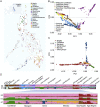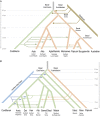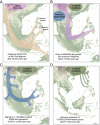Multiple migrations to the Philippines during the last 50,000 years
- PMID: 33753512
- PMCID: PMC8020671
- DOI: 10.1073/pnas.2026132118
Multiple migrations to the Philippines during the last 50,000 years
Abstract
Island Southeast Asia has recently produced several surprises regarding human history, but the region's complex demography remains poorly understood. Here, we report ∼2.3 million genotypes from 1,028 individuals representing 115 indigenous Philippine populations and genome-sequence data from two ∼8,000-y-old individuals from Liangdao in the Taiwan Strait. We show that the Philippine islands were populated by at least five waves of human migration: initially by Northern and Southern Negritos (distantly related to Australian and Papuan groups), followed by Manobo, Sama, Papuan, and Cordilleran-related populations. The ancestors of Cordillerans diverged from indigenous peoples of Taiwan at least ∼8,000 y ago, prior to the arrival of paddy field rice agriculture in the Philippines ∼2,500 y ago, where some of their descendants remain to be the least admixed East Asian groups carrying an ancestry shared by all Austronesian-speaking populations. These observations contradict an exclusive "out-of-Taiwan" model of farming-language-people dispersal within the last four millennia for the Philippines and Island Southeast Asia. Sama-related ethnic groups of southwestern Philippines additionally experienced some minimal South Asian gene flow starting ∼1,000 y ago. Lastly, only a few lowlanders, accounting for <1% of all individuals, presented a low level of West Eurasian admixture, indicating a limited genetic legacy of Spanish colonization in the Philippines. Altogether, our findings reveal a multilayered history of the Philippines, which served as a crucial gateway for the movement of people that ultimately changed the genetic landscape of the Asia-Pacific region.
Keywords: Austronesian; ISEA; Negrito; Philippines; human population genetics.
Copyright © 2021 the Author(s). Published by PNAS.
Conflict of interest statement
The authors declare no competing interest.
Figures



Similar articles
-
Taiwan Y-chromosomal DNA variation and its relationship with Island Southeast Asia.BMC Genet. 2014 Jun 26;15:77. doi: 10.1186/1471-2156-15-77. BMC Genet. 2014. PMID: 24965575 Free PMC article.
-
Philippine Ayta possess the highest level of Denisovan ancestry in the world.Curr Biol. 2021 Oct 11;31(19):4219-4230.e10. doi: 10.1016/j.cub.2021.07.022. Epub 2021 Aug 12. Curr Biol. 2021. PMID: 34388371 Free PMC article.
-
Cranio-morphometric and aDNA corroboration of the Austronesian dispersal model in ancient Island Southeast Asia: Support from Gua Harimau, Indonesia.PLoS One. 2018 Jun 22;13(6):e0198689. doi: 10.1371/journal.pone.0198689. eCollection 2018. PLoS One. 2018. PMID: 29933384 Free PMC article.
-
Terror from the sky: unconventional linguistic clues to the negrito past.Hum Biol. 2013 Feb-Jun;85(1-3):401-16. doi: 10.3378/027.085.0319. Hum Biol. 2013. PMID: 24297235 Review.
-
Peopling of the Americas as inferred from ancient genomics.Nature. 2021 Jun;594(7863):356-364. doi: 10.1038/s41586-021-03499-y. Epub 2021 Jun 16. Nature. 2021. PMID: 34135521 Review.
Cited by
-
The Allen Ancient DNA Resource (AADR) a curated compendium of ancient human genomes.Sci Data. 2024 Feb 10;11(1):182. doi: 10.1038/s41597-024-03031-7. Sci Data. 2024. PMID: 38341426 Free PMC article.
-
Fine-Scale Population Admixture Landscape of Tai-Kadai-Speaking Maonan in Southwest China Inferred From Genome-Wide SNP Data.Front Genet. 2022 Feb 17;13:815285. doi: 10.3389/fgene.2022.815285. eCollection 2022. Front Genet. 2022. PMID: 35251126 Free PMC article.
-
Reanalyzing the genetic history of Kra-Dai speakers from Thailand and new insights into their genetic interactions beyond Mainland Southeast Asia.Sci Rep. 2023 May 24;13(1):8371. doi: 10.1038/s41598-023-35507-8. Sci Rep. 2023. PMID: 37225753 Free PMC article.
-
Urbanization and genetic homogenization in the medieval Low Countries revealed through a ten-century paleogenomic study of the city of Sint-Truiden.Genome Biol. 2025 May 20;26(1):127. doi: 10.1186/s13059-025-03580-z. Genome Biol. 2025. PMID: 40390081 Free PMC article.
-
Genome diversity and signatures of natural selection in mainland Southeast Asia.Nature. 2025 Jul;643(8071):417-426. doi: 10.1038/s41586-025-08998-w. Epub 2025 May 14. Nature. 2025. PMID: 40369069
References
-
- Détroit F., et al. ., A new species of Homo from the Late Pleistocene of the Philippines. Nature 568, 181–186 (2019). - PubMed
-
- Mijares A. S., et al. ., New evidence for a 67,000-year-old human presence at Callao Cave, Luzon, Philippines. J. Hum. Evol. 59, 123–132 (2010). - PubMed
-
- Reid L. A., Who are the Philippine negritos? Evidence from language. Hum. Biol. 85, 329–358 (2013). - PubMed
Publication types
MeSH terms
LinkOut - more resources
Full Text Sources
Other Literature Sources

